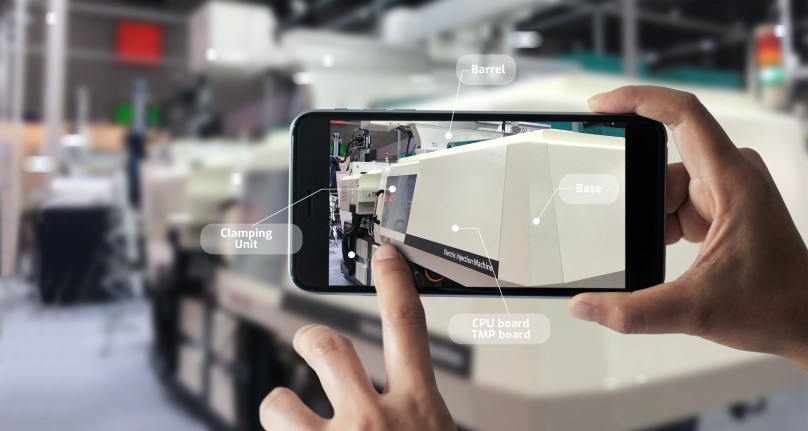Contents
- What Is Remote Assistance AR?
- How Does Augmented Reality Remote Assistance Work?
- Remote Assistance AR Business Applications
- Who Benefits From Using AR Remote Assistance?
- Which Industries Use Remote Assistance AR?
- How To Choose Your AR Remote Assistance Software?
- AR Remote Assistance: Now and for the future
Remote assistance AR has gained immense popularity and is expected to continue evolving and seeing growth in 2022 and beyond, as more industries move to incorporate innovative technologies to step up their remote customer service offering and tech support.
Two main “events” have had a transformational impact on the remote assistance landscape – emerging technologies, and the COVID-19 pandemic, which underscored the need for urgent changes to adapt to new norms, limitations and challenges of remote support, as well as to ensure business continuity. Many companies have since embraced AR technology to enhance virtual assistance.
Augmented reality technology has streamlined operations and changed the face of remote assistance forever – taking it to the next level. An industry game-changer – check. Businesses love it – check. Technicians love it – check. Yes, it is a powerful solution. But – what exactly is it? Let’s get down to the basics – and the benefits.
What Is Remote Assistance AR?
Augmented reality remote assistance enables brand agents and product experts to visually guide and collaborate with customers and field technicians, with no geographical constraints. Live video streaming and images in real time and interactive AR-powered technology seamlessly bridge the physical and virtual worlds and speed up the process of resolving issues.
Download this success story to learn how leading payment processor Comdata slashes AHT by 20%
Remote assistance AR is a cost-effective technology that easily integrates across devices, linking the contact center and headquarters to the customer’s home, to the field technician, remote expert, or contractor. It can be used from basic troubleshooting with customers to helping technicians execute complex field repairs on site. It enables customers with technical difficulties to get the support they need easily and effectively – without going through a complicated process to identify and resolve a technical issue. It’s more “show” – and less need for “tell.”
How Does Augmented Reality Remote Assistance Work?
AR remote assistance technology combines live video streaming with augmented reality, an interactive technology that superimposes a computer-generated image on a user’s view of the physical environment. The combination of these two technologies creates a powerful collaborative solution for remote guidance. More efficient than auditory communication, visually demonstrating the desired action enables the customer to comprehend and execute the instructions faster.
Remote Assistance AR Business Applications
Harnessing the power of AR remote assistance platforms, businesses are providing customers, agents, and technicians with a solution for quick resolutions with minimal effort, maximum success, and a better customer experience.
AR technology efficiently provides technical information, guidance, content and other support capabilities based on collaboration, knowledge-sharing, and simplification of complicated processes. New applications driven by the COVID-19 pandemic even implement AR remote assistance to provide customers with a virtual “try-before-you-buy” experience.
Technical Support
Agents can use remote assistance AR to quickly identify and resolve common technical issues from afar, by viewing the equipment and visually guiding the customer through the steps. Overlaying visual instructions on the screen and making annotations to simplify instructions, agents can assist customers through solving cable wire issues, helping buyers to unbox and install a new appliance, clean their washing machine filters, or fix internet connectivity.
Here are three areas of technical support where AR is particularly useful:
- Augmented Reality User Manuals: Augmented Reality is the perfect tool for creating product manuals and guiding consumers through technical support scenarios. It easily and clearly shows customers the actions and adjustments they need to make to reach the desired outcome.
- Augmented Reality Remote Assistance: Without having to send a technician, an agent located anywhere in the world can be virtually ‘transported’ to a customer’s location in an instant. By utilizing the customer’s phone camera, the agent can see in real time what the customer is talking about and offer remote video support. The agent provides a sequence of actions that will resolve the issue and guides the customer with AR to clearly show the steps they need to take.
- Augmented Reality Customer Service: AR is perfect for delivering real-time customer support. It allows the agent to guide the customer through a process with visual assistance, eliminating the biggest problem – miscommunication. With AR, the agent shares virtual elements by adding markups to the image the customer sees, explaining a bill or showing how to fill out a form. Visual guidance is simply more effective. It’s as if the agent is standing right beside the customer, showing them exactly what to do.
Field Services
AR remote assistance puts all necessary data and instructions in technicians’ hands in real-time. AR can help technicians gain immediate access to remote experts when necessary, streamline the field service process, quickly execute field repairs, or even communicate with customers. For example, they can use AR to survey a location prior to a dispatch or follow up after a visit. According to Gartner, by 2025, over 50% of field service management deployments will include AR-based tools and collaboration support, up from less than 20% in 2021.
Billing Proofs and Contracting Issues
Sharing the view of a physical document makes it easy to pinpoint and resolve issues. Agents with AR remote assistance tools can easily review, verify and clarify documents, invoices, and contracts in real-time facing customers. The technology also allows agents to confirm, record and add data to CRM systems, gather proof of identity, validate coupons, or see evidence of damaged goods prior to authorizing returns, for faster and more accurate processing.
Who Benefits From Using AR Remote Assistance?
AR remote assistance provides high-quality capabilities that enhance field service and customer service – for the technician, the agent, and the customer. Reducing the need for site visits, faster diagnosis, resolution and increased productivity are directly related to cost savings, efficiency and customer satisfaction – for overall benefit to businesses.
Customers
AR remote assistance creates a unique customer experience. Today’s tech-savvy customers expect immediate, efficient remote assistance combined with a rich visual, digital experience, which is what AR technology is all about.
Customer Service Organizations
Implementing AR remote assistance streamlines operations and empowers customer service representatives. Contact center agents can visually guide consumers in solving their technical problems, providing real-time assistance and solutions. This improves customer satisfaction, increases call center efficiency, reduces labor intensity, and empowers call center agents to function as virtual technicians, preventing unnecessary truck rolls and overall reducing costs.
Field service organizations
Customer service agents can send field technicians visual data from customer service agents prior to being dispatched. This enables them to plan repairs before arriving on site. Technicians can transmit video and images of technical issues from the field while consulting with an expert or supervisor, located either in the field or at headquarters. This shortens time to resolution and increases first-time-fix rate.
AR remote assistance can also help facilitate teaching and virtual training, saving time, effort, logistics and resources while bringing new technicians up to speed.
Which Industries Use Remote Assistance AR?
AR remote assistance is widely used across many different industry and business practices– including telecommunications, utility companies, consumer electronic brands, insurance and financial organizations, retail, IT, and more. AR technology facilitates a range of services and processes. Lets look at a few examples.
Communication Service Providers
Remote assistance augmented reality helps ensure more efficient issue resolution, less costly hardware replacements and truck rolls, and higher levels of customer satisfaction. For example, an agent can see the connections on the back of a customer’s router or modem to understand the problem and guide the customer to a quick fix. Telecommunications companies, like Vodafone can harness remote assistance AR to better support their customers, and ensure seamless transitions resulting from digital transformation like facilitating the 5G roll out.
Consumer Electronics
Customer service agents can provide better support from installation and setup to updates and repairs for smart devices, appliances, or any other equipment.
Utility Companies
AR remote assistance can improve the way utility companies process and resolve inquiries, including troubleshooting and maintenance, hazard reporting, billing inquiries and installation guidance, as well as promote safety in the field, which in turn promotes adoption of devices and boost customer satisfaction.
Insurance and Financial Institutions
Customers can gain clarity on billing and invoice inquiries. Agents can use the technology to gather visual evidence or proof for disputes, enabling customers to transmit images and videos of claims for improved documentation handling and reduced fraud.
The technology also helps support insurance-based IoT devices, such as in-vehicle telecommunication devices, smart smoke and CO detectors, and digital doorbells. These are increasingly being used for alerts, damage detection, and risk and claim assessment.
How To Choose Your AR Remote Assistance Software?
There are three key areas to consider while selecting an AR remote assistance solution: integration, compatibility, and features. The platform should efficiently connect customer service agent, technician, and customer with minimal friction and maximum engagement.
Integration
Your AR solution should easily integrate into your organization, user-friendly and with a short transitional period.
Compatibility
Does your solution support all mobile devices, tablets, smart glasses, wearables? Make sure it is compatible with multiple devices and operating systems to meet your current and future needs.
Features
Key features of your AR remote assistance solution should include:
- Clear AR annotation tools, file transfer capabilities, robust security and privacy protocols, digital signatures, analytics and reporting tools.
- A robust knowledge base should feature CRM integration, customer history for recurring issues, a visual agent reference library for best-path resolutions, and embedded visual call script guidance.
- Simple and intuitive for all users
AR Remote Assistance: Now and for the future
With multiple – and increasing – use-cases and capabilities for AR technology, remote assistance will never be the same. In fact, analysts predict that the global AR market as a whole is expected to surpass $48.6 billion by 2025. In a market with growing adoption, capabilities and applications, this technology is being leveraged across major industries for remote assistance. Augmented reality remote assistance continues to evolve to directly affect core KPIs, to improve productivity, efficiency, and customer satisfaction, and to facilitate business continuity and growth.






